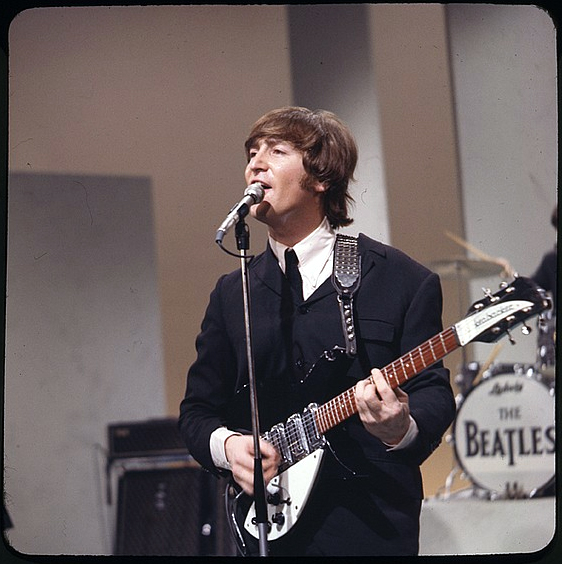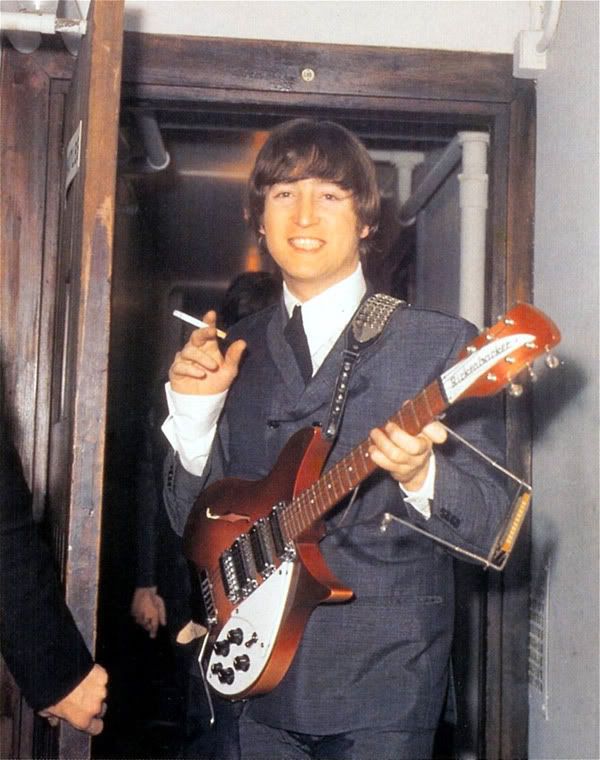- This topic has 0 replies, 1 voice, and was last updated 1 month, 1 week ago by
 chubes.
chubes.
Log in to view. Or, click here to read the blog version of this post (with ads).
-
#26460| March 23, 2024 at 3:05 am
 chubesHMFICRank: Frozen Foods IslePoints: 10443.75
chubesHMFICRank: Frozen Foods IslePoints: 10443.75The History of John Lennon’s Rickenbacker 325 Guitars
Published: December 4, 2021
John Lennon and Paul McCartney on the set of The Ed Sullivan Show in NYC in 1964. John is holding his 1958 Rickenbacker 325. John Lennon of The Beatles was a renowned figure for many reasons, from songwriting to activism and of course his notorious relationship with Yoko Ono. In addition to all these things, John Lennon (and later Paul and George) was also known for his affinity towards the Rickenbacker 325 guitar.
Some speculate that Rickenbacker would not have become such a successful guitar company without John Lennon and the Beatles
While the company had been around since 1931, and are actually credited with being the first company to manufacture an electric guitar, it wasn’t until the Beatles started playing and them and subsequently rose to international fame that the Rickenbacker brand truly took off.
The Rickenbacker 325 was designed by Roger Rossmeisl, who worked at Rickenbacker for eight years prior to being hired by Fender. He was personally responsible for many of the most popular designs at Rickenbacker, including the 325 model that was used by Lennon.
The instrument features a hollow body, a C-shaped sound hole (though not Lennon’s, for reasons you’ll soon find out), and an exceptionally short scale that measures only 203⁄4 inches.
John Lennon played four different Rickenbacker 325s over the course of his career with the Beatles. He did play other guitars as well, but he always went back to his trusty Rickenbackers.
Read on to learn about all of John Lennnon’s Rickenbacker guitars.
1958 Rickenbacker 325, “Hamburg”

John Lennon during the Beatles first Ed Sullivan Show appearance, February 9th, 1964. Playing his 1958 Rickenbacker 325 The first Rickenbacker 325 that John Lennon owned was a 1958 Capri model, with a natural finish and a serial number “V81”. This is his most famous guitar as it was the one he played during the Beatles’ initial rise to fame.
It was the one that he played during the Beatles’ first appearance on the Ed Sullivan Show on February 9th, 1964, which marked the first time that many Americans had heard of the Beatles, and thus sparked the Beatlemania phenomenon across the country.
The story goes that Lennon and the Beatles had gone to see the jazz artist Toots Thielemans perform while on tour through Hamburg, Germany in 1960, and Toots was playing a Rickenbacker.
Lennon apparently took a liking to the guitar (the fact that it was American-made likely added to this appeal) and went to purchase one from Steinway’s music store in Hamburg shortly after. For this reason, John Lennon’s first Rickenbacker 325 is nicknamed “Hamburg”.
Lennon’s 1958 Rickenbacker 325 was actually one of the first ones that the company ever made, and was rare for reasons other than the musician who played it, as it was only one of 8 natural finish 325s that the company made in 1958 and it did not include a sound hole, though it was hollow-bodied.
The lack of a sound hole gives the illusion of the instrument being solid-bodied, and one can assume that Rickenbacker added the sound hole to serve as a visual indicator of it being a hollow-bodied instrument.

John Lennon at the Star Club in Hamburg, 1962. Holding his 1958 Rickenbacker 325, pre-refinish. Rickenbacker 325 models produced after 1958 all included a crescent moon shaped sound hole. At least until the 1970s when the company began manufacturing replicas of the Rickenbacker without a sound hole played by John Lennon.
Soon after purchasing the guitar, Lennon began to make numerous modifications to the original instrument. The first thing he did was replace the Rogan stove knobs with four Hofner teacup style knobs. He also replaced the original Kauffman vibrola with a better one made by Bigsby.
It is also said that Lennon disconnected the middle pickup on the guitar, because he didn’t like hearing the amplified clicks that would occur when he would strike it with his pick. Sometime around September 1962, John Lennon also had the natural finish painted over with a glossy black.
The guitar was eventually retired in 1964 for a time after he was given his second Rickenbacker 325, and many fans mistakingly thought that it had been stolen.
This was proven untrue in the early 1970s when Lennon brought the guitar out of retirement, and in 1972 he hired the noted guitar repairman Ron DeMarino of Long Island, NY to restore it.
According to DeMarino, it was in pretty poor shape at the time, with mismatched strings and a bird’s nest of wires inside the body. He rewired the whole thing, even reaching out to Rickenbacker for the original wiring diagram, and installed a new pickguard in place of the old, beat-up one.

John Lennon’s original 1958 Rickenbacker 325, as it is today. See more photos here. In addition to the overhaul that the instrument received internally, Lennon also requested that the guitar be restored to its original natural finish.
DeMarino however was not aware that it had been a natural, honey-colored finish originally, and ended up giving it a plain maple finish instead, which is how the guitar stands today.
It is said that Lennon began using his 1958 Rickenbacker 325 extensively again during the final years of his life, and that he had it in the studio with him during the recording sessions for Double Fantasy (1980) and his final album, Milk and Honey, which was released posthumously in 1984.
John’s original 1958 Rickenbacker 325 is now owned by Yoko Ono.
1964 Rickenbacker 325, “Miami”

John Lennon’s second Rickenbacker 325 was delivered to him at the Hotel Deauville in early February 1964, serial “DB122”. It was a a gift from Rickenbacker while the Beatles were touring in America for the first time, and it quickly replaced the “Hamburg” 325 as his main guitar.
The instrument was first played in public by John Lennon during the on-set rehearsal for their second appearance on the Ed Sullivan show on February 17th, 1964, just one week after they had appeared for the first time and taken the nation by storm.
It was a brand new 1964 Rickenbacker 325, painted JetGlo black and very much an updated version of his beloved 1958 Rickenbacker. The guitar was made specifically for Lennon after Rickenbacker president F.C. Hall caught wind that the band had been using their instruments.
He had initially planned to have it ready for their arrival in the states, but was not able to make it happen thus it was delivered to the Miami hotel instead. He did, however meet with the Beatles backstage at Ed Sullivan’s studio before their first appearance.
Lennon played this new Rickenbacker as his primary instrument for most of 1964 and 1965.
It was temporarily out of commission during the Beatles 20 show run for Christmas 1964 at the Hammersmith Odeon in London after he dropped it on stage. He didn’t think it was badly damaged at the time, so he brought it back out the next night only to find that the body had a large crack running from the nut around the back of the headstock, rendering it unplayable.
In its place as a temporary replacement was a Rose-Morris model Rickenbacker 1996, which I’ll talk about more later on. John played the Rose-Morris for one or two shows before a more serviceable repair could be made to his broken Rickenbacker 325.
Once it was returned to him, it served as his main guitar until the end of the Beatles.

Beatles 1966 tour setlist taped to John’s 1963 Rickenbacker 325. Naturally, since it was played by John Lennon, the guitar picked up some character along the way. Firstly, he bent the tremolo bar into a 90 degree angle, presumably to get it out of the way.
After the 1964 Christmas shows, it also sported a permanent crack that is still visible today. He also taped the setlist for the Beatles 1966 tour to the top of the headstock, which is also still in place today.
After Lennon’s death, the guitar went to Yoko Ono. From 2000 to 2010 it was on display at the John Lennon Museum in Japan. In February 2014, Yoko Ono loaned the instrument to the Rock and Roll Hall of Fame for the 50th anniversary of the British Invasion.
Rose-Morris Rickenbacker Model 1996

John Lennon with his Rose-Morris Rickenbacker, backstage at the Hammersmith Odeon in 1964. The Rose-Morris Rickenbacker 1996 was Lennon’s third Rickenbacker guitar, and the one he played the least. Rose-Morris manufactured the British version of the Rickenbacker 325 and called it the 1996.
The one that was gifted to Lennon after he broke his 1963 Rickenbacker was finished in fireglo red sunburst rather than the black that John liked at the time, and it featured a classic “f” sound hole rather than the crescent or the lack of sound hole featured on other Rickenbackers.
Clearly John did not like playing the Rose-Morris nearly as much as his faithful Rickenbacker, as he never played it again after the Christmas shows in 1964. The guitar went into a corner after the shows and at some point in the late 1960s he gifted it to Ringo Starr.

Ringo owned the Rickenbacker until December 2015, when he held an auction that included the guitar along with a bunch of other old Beatles stuff. The guitar went for $910,000, and the auction overall netted $9.2m.
Although Lennon only played the guitar for a short while, Rose-Morris decided to capitalize on the event by running ads for their guitars with John Lennon’s photo on them.
Lennon’s 12-String Rickenbacker 325

When Lennon met with F.C. Hall in February 1964, he asked Hall to make him a 12-string version of his Rickenbacker 325. Hall obliged and had the guitar made for Lennon the next month, and shipped it to him in London March of 1964.
The guitar looks just like his 1963 Rickenbacker, except it has a slightly different headstock and tailpiece.
Lennon did not play this one in public very often, just bringing it along as a backup. though he did appear with it on a Dutch TV show and notably played it in the studio on the album Beatles for Sale.
You can hear the difference clearly during the guitar break on “Every Little Thing”.
It was also played in the studio on other occasions, and he used it at home for songwriting purposes. The one concert during which he played the 12 string as his main instrument was in Boston on September 12th 1964.
Today the instrument is owned by the Lennon Estate, and was also on display at the Rock and Roll Hall of Fame Beatles Exhibit in recent times.
- You must be logged in to reply to this topic.
Users Currently Online: 0
Most Ever Online: 8 on 02/06/2024
Total Members: 180